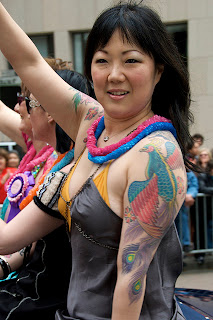10/10: opening the cupboard
 Our first stop yesterday was the Tiong Bahru bird area, where older Chinese men bring their birds to sing to each other on Sunday mornings. The morning was rainy-misty, sort of like Seattle in July. The birds were these little green and yellow guys in wooden cages decked out with carvings and ivory ornaments. I thought they all looked like the “after” pictures from Pimp My Cage. Ryan said he would remember that when he taught parody to his class.
Our first stop yesterday was the Tiong Bahru bird area, where older Chinese men bring their birds to sing to each other on Sunday mornings. The morning was rainy-misty, sort of like Seattle in July. The birds were these little green and yellow guys in wooden cages decked out with carvings and ivory ornaments. I thought they all looked like the “after” pictures from Pimp My Cage. Ryan said he would remember that when he taught parody to his class.We stopped at a hawker center for breakfast, sort of like Grand Central Market but cleaner and Chinese. Lots of food booths and little tables beneath a tall tin roof. I ate fish congee (porridge) and drank a venti-esque cup of grass jelly juice.
In the afternoon we visited the Changi Prison Museum. At first I thought we were going to get to visit a real Singapore prison. I’d just read an article in other magazine by a person who’d toured a Bolivian prison, apparently a regular occurrence. But while the current real prison is called Changi Prison, this was a replica of a chapel built at the old Changi, which Japan turned into a POW camp for soldiers, British colonials and locals during World War II. Turns out the Japanese treated everyone there pretty shittily, as runners of prison camps are known to do.
The letters and photos and artifacts made me realize how much my education focused on the Western front of WWII and the West in general. That’s happening over and over this trip. It’s not as if I really thought I knew much about Asia beforehand, but, well, say you had a cupboard in your house that you’d never opened. You would admit that you had no idea what was inside and that you were sort of curious. But say you were able to open it just a crack one day, and out fell, for example, a football, a peach and a glass eye. All of a sudden you’d be really curious. You’d want to know how these things fit together and fit with the rest of the known objects in your house.
Ryan says Singapore is unusual because it’s proud of its colonial past, not like Africa, where he also lived. I said maybe the difference is how the particular colonists treated the particular locals. “You mean like because they didn’t export them as slaves?” he said. “Yeah,” I said. Still, according to the Changi Prison Museum, the Japanese invasion was a wake-up call that the paternalistic British were pretty pathetic parents, surrendering almost immediately. The Japanese claimed that “Asia should be run by Asians.” Of course, you have to question this seemingly noble statement when you look at the torture of thousands of Chinese people, but still, it would have been nice in school if someone had mentioned that Japanese aggression was on some level a reaction to years of colonial rule in Asia. That it wasn’t just a Pinky and The Brain plot, where one day they woke up and said, “Let’s take over the world.”
We tagged along to Ryan’s Kundalini yoga class, taught by a French woman named Christine. Stretched and breathed the tropical breeze in her living room, un-crunched my muscles after a day of walking.
After dinner we visited a gay bar called, I think, Tantric. I thought it would be more underground, but it was pretty much like West Hollywood, maybe mellower and more ethnically diverse. Even the gay bar we went to in Prague a few years ago felt kind of dangerous, the bouncer locking the door after we slipped inside. We met up with a handful of Ryan’s friends and acquaintances, two Singaporeans, a white American guy and a Chinese British girl. This whole ex-pat life is new and glamorous and intimidating. I am such a local girl. I can’t go five minutes without talking about LA.



Comments